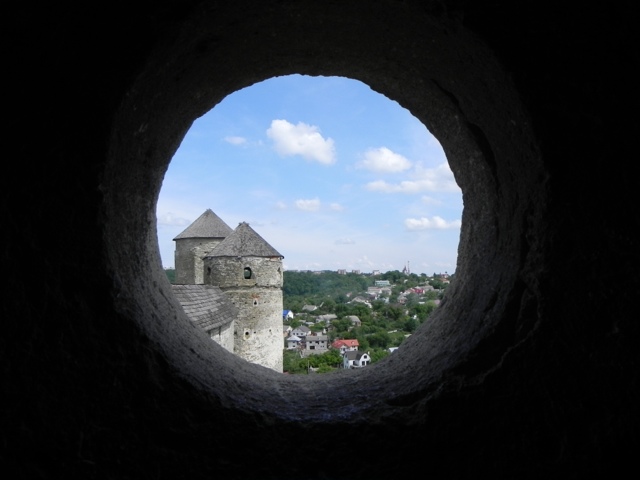I am not prepared to draw reflective conclusions at this point in my trip; however, I am feeling a sense of closure. My visits to the Liebross and Wenkert communities are over. Further research will entail evaluating records I've collected thus far and the experiences I've had in the ancestral communities I've had the pleasure to visit. It's all part of the research process. Records are one thing, but being able to put past lives in context - even if that context is based on current sights and experiences - is closer to the goal of my work.
Alex must have experience with this type of transition, as he stopped on our way from Zaleszczyki to Kamyanets-Podilskyy at the town once on the border between the Austrian and Russian Empires: Skala-Podilska. This village once housed an Austrian garrison. The Zbrucz River was the boundary between the two empires. The ruins of a Polish castle and fortification stand overlooking the river and the old Russia Empire, beyond (this is my daughter with the castle wall and Russia behind her).
The village, like so many border areas throughout history, had a thriving smuggling economy.
We crossed into Podolia and continued on to Kamyanets Podilskyy: a jewel. KP features a beautiful Ruthenian-Lithuanian castle first constructed in the 1400s. It has had numerous owners and phases of building and renovation. At one point, it was part of a Polish Fortress. The KP castle is nearly surrounded by the Smotrych River and, due to its strategic location along heavily used trade routes, was an object of desire for many kingdoms.
It withstood several attempts of conquest. The settlement changed hands a few times and Poles, Turks, Ruthenians, Russians and Germans were among the rulers. One of the more interesting effects of this history is the Catholic Church that features a minaret (added while KP was under Ottoman rule and adaptively reused by the Catholics when the city was retaken: they put a statue of Mary on top).
Below the castle fortifications (at the bottom center of the KP castle photo, above) is the Karavansary - the area where Jewish people lived just outside the castle walls. There were times when Jewish people were welcome to live within the walled city, but most of the time they were limited to the surrounding villages (I believe they were allowed in when the marauding hordes came by to attempt conquest).
Here is another view of the castle taken from the Karavansary area (standing next to a very nice wooden church).
This is a later synagogue built near one of the early tower fortifications around the city. The synagogue now serves as a restaurant.
KP sports very nice Hapsburg era architecture. With, sometimes, some innovative touches.
Tomorrow we head to the archives in Khmelnitsky to begin my quest for Volhynia Gubernia records. I am very much looking forward to this new phase of research and exploration.
I'll close with some views of and from the KP castle.












No comments:
Post a Comment
Comments on posts are always welcome but will be approved before posting. I actually prefer to just let people comment without going through this rigmarole, but I've recently had to delete some posts that I had not vetted before publication. So, please don't be offended. I love to hear from you!